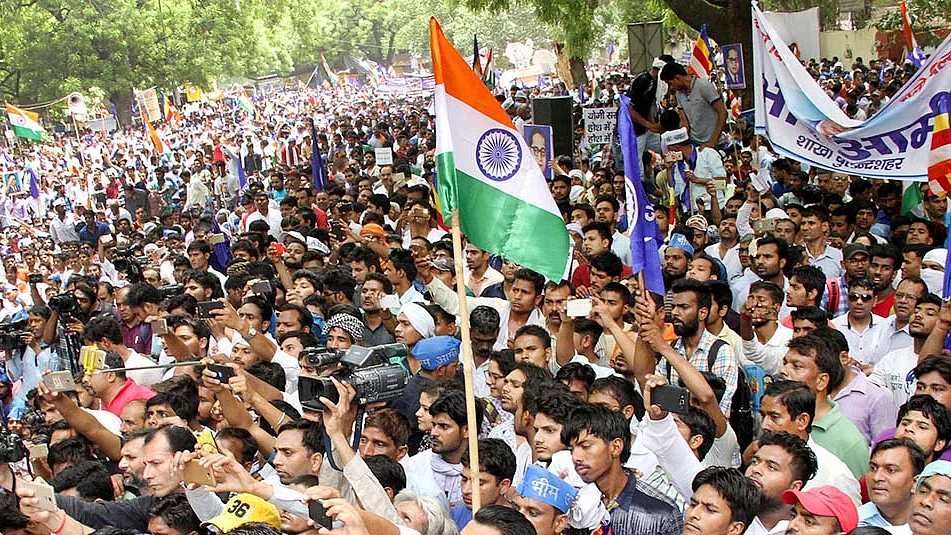An angry, young Dalit assertion like never before
The Bhim Army banner in western UP marks the birth of an angry Dalit, replacing the centuries-old docile one. This could lead to a million mutinies, challenging established social and political order

Western Uttar Pradesh seems to be heading towards a major caste confrontation between Thakur-led upper castes and the lowest rung of Hindu society, Dalits. From Saharanpur to Meerut and Agra to Aligarh, including Mordadabad, all major cities in the region are literally on the boil as caste clashes are becoming the order of the day.
Delhi’s Jantar Mantar witnessed a major Dalit rally on Sunday, as thousands of Dalits from the region protested under the Bhim Army banner against the alleged “Thakur atrocities”. Dalit anger was clearly visible on the streets of Delhi as thousands participated on the call of Bhim Army President Chandrashekhar Azad.
Chandrashekhar Azad is apparently an emerging Dalit icon who comes from Saharanpur. Quitting his legal practise, the 30-year-old Dalit leader has plunged himself full-time into Dalit politics and successfully managed to get the attention—of both the people and the media—on the rising Dalit assertion in many parts of Uttar Pradesh.
Azad initially started with a social movement working for educational upliftment among Dalits. But, the Thakur-Dalit clashes in Shabirpur village of Saharanpur district sucked him and his Bhim Army into a major political campaign against Dalit “atrocities in the region”.
The Dalit anger against upper castes spilled over to streets apparently after Thakurs of Saharanpur attacked and set on fire Dalit housing clusters in Shabirpur village after a group of Dalit youth stopped a Thakur procession taken out to celebrate Rajput icon Maharana Pratap’s birthday.
It led to clashes between the two groups in which one Rajput died leading to major retaliatory violence in which Dalit houses were burnt on May 5.
One incident or the other of mostly Rajputs taking on Dalits have been reported since then from cities like Meerut, Aligarh, Agra etc leading to at times violent Dalit backlash, which is a new phenomenon in this part of Uttar Pradesh.
Dalits are now so angry that they are openly threatening to walk out of the Hindu fold. There have been reports of 50 Dalit families embracing Buddhism in Saharanpur and a few thousands in Aligarh, Badaun and Agra threatening to convert to Islam.
Dalit politics in Uttar Pradesh has had major ups and downs in the last three decades. It took a dramatic turn in 1993 when Bahujan Samaj Party under late Kanshi Ram’s leadership forged an electoral alliance with Mulayam Singh Yadav’s Samajwadi Party. The BSP-SP alliance stunned political pundits with their electoral victory in 1993 as the two parties jointly formed the UP government with Yadav taking the office of the state chief ministership.
It was a major political development transforming UP power politics for nearly three decades. First, the SP-BSP victory in 1993 had come too soon after the demolition of the Babri mosque at Ayodhya in December 1992 which had polarised UP along Hindu-Muslim lines.
Instead, the Yadav-Kanshi Ram tie-up managed to sew up a new backward-Dalit-Muslim alliance, which halted the march of Hindutva politics in India’s most populous state that sends the largest number, 80 to be exact, of members to the Lok Sabha.
Both the BJP and the Congress Party could barely manage to come to power with the rise of the Samajwadi Party and BSP in UP since then. The SP-BSP alliance, however, soon broke down in 1995.
However, both the parties managed to corner power between themselves for over three decades with Mulayam and Mayawati rotating as UP chief minister between them. Mulayam’s son Akhilesh Yadav headed the last government of this sort between 2012-2017.
Narendra Modi, in the 2014 parliamentary elections, broke this jinx by winning 71 seats for the BJP—apart from the two seats won by its ally, Apna Dal—in UP. Modi’s massive haul for BJP was also seen as the return of upper caste dominance and the retreat of OBC-Dalit politics in UP. The 2017 UP Assembly elections brought the BJP back to power with a thumping majority that led to the rise of Yogi Adityanath as the state chief minister.
Yogi is a Thakur and has been the chief priest of famous Gorakhnath Math which is famous for Rajput assertion in the region. The return of a Rajput chief minister after a long gap of many decades seems to have led to Rajputs in UP to assert themselves, especially against Dalits in rural areas which is largely fuelling the Dalit anger in UP.
But, the face of the Dalit anger this time is very different than what it was in the 1990s, when the first Dalit party led by Kanshi Ram and Mayawati came to power. It is young, angry and assertive this time. Unlike the 1990s, when it largely banked on electoral politics, the new Dalit is quick to take to the streets. He is even willing to retaliate as it did in Saharanpur.
It is, in fact, the birth of an angry Dalit replacing the centuries old docile one who was ever ready to accept even the worst as his fate—very well depicted by doyen of Bengali cinema Satyajit Ray in his Hindi TV film Sadgati (The Deliverance), which was based on a Munshi Premchand short story.
The New Dalit believes in ascent rather than descent. And, this could lead to million mutinies challenging established social and political order in the long run, if not too soon.
Follow us on: Facebook, Twitter, Google News, Instagram
Join our official telegram channel (@nationalherald) and stay updated with the latest headlines
- Saharanpur
- Aligarh
- Uttar Pradesh
- Bahujan Samaj Party
- Samajwadi Party
- Agra
- Meerut
- Kanshi Ram
- Jantar Mantar
- Maharana Pratap
- Rajput
- Thakur Dalit clashes
- Bhim Army
- Chandrashekhar Azad
- Dalit protest
- caste confrontation
- Mordadabad
- Thakur atrocities
- Shabirpur village
- Dalit atrocities
